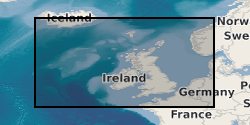Marine geological sample data from around the UK (1966 onwards)
The British Geological Survey has collected over 50,000 offshore samples using grabs, dredges and shallow coring devices (to a maximum depth of 6m below the sea bed). The collection also includes additional third party data and has assisted in the creation of BGS marine geology maps. The distribution is variable, but in general there are sample stations spaced approximately every 5 - 10 km across the entire UK Continental Shelf (UKCS), and in some localised areas the sampling density is much higher. The data held include digital data and analogue records (sample data sheets), plus associated physical sample material. Sample data sheets, which have been scanned, contain index information and geological descriptions. They become more detailed from 1983 onwards. Coded geological descriptions were entered on sheets which were subsequently digitized, and this information is available for about 10,000 samples. The data also includes results of analyses such as micropalaeontological examination or age dating. All sample material is managed as part of the BGS materials collection and are available for examination and subsampling. The data are stored within the National Geoscience Data Centre (NGDC) and Marine Environmental Data and Information Network (MEDIN) Data Archive Centre (DAC) for Geology and Geophysics. These geological data are delivered via the BGS GeoIndex. Separate layers are provided for different types of sample: borehole-type samples, grab samples and other equipment types. These layers contain the geological data, and metadata about the samples themselves, as well as links to scanned datasheets and core logs, are provided in separate metadata layers. For some of these samples, particle size analysis (PSA), geochemical and geotechnical data are also available, and these data are provided in separate layers. The data are applicable to a wide range of uses including environmental, geotechnical and geological studies. Reference: Fannin, NGT. (1989) Offshore Investigations 1966-87. British Geological Survey Technical Report WB/89/2, British Geological Survey.

dataset
GeoIndex Offshore
- BGS GeoIndex is a web tool for professional users who need to access BGS data as part of their business requirements. The map viewer is free to use and is designed to work on desktop and mobile devices.
GeoIndex_Offshore_offshore_data
- One or more layers for the dataset is provided through this OGC WMS (view) service. This URL is the service end-point and is intended for consumption by software clients that understand the WMS API.
:
http://data.bgs.ac.uk/id/dataHolding/13605643
English
Geoscientific information
GEMET - INSPIRE themes, version 1.0:
BGS Thesaurus of Geosciences:
Core drilling
Geological data
Marine surveys
Marine geology
Bottom sampling
Core logs
Geological surveys
Geology
Absorbents
Marine sediments
Boreholes
MEDIN
Sea floor sediments
EGDI
UK Location (INSPIRE)
Free:
Free:
NERC_DDC
-25.0000,
48.0000,
9.0000,
65.0000
CELTIC SEA [id=2001353], ENGLISH CHANNEL [id=2001401], IRISH SEA [id=2001430], NORTH SEA [id=2001452], UK CONTINENTAL SHELF [id=121701]
creation: 1966
1966
-
?
vector
British Geological Survey
Enquiries
The Lyell Centre, Research Avenue South,
EDINBURGH,
EH14 4AP,
United Kingdom
tel: 0115 936 3142
email:
[email protected]
Role: distributor
British Geological Survey
Enquiries
The Lyell Centre, Research Avenue South,
EDINBURGH,
EH14 4AP,
United Kingdom
tel: 0115 936 3142
email:
[email protected]
Role: point of contact
Data Quality
Core material and seabed samples were collected during offshore surveys using various sampling techniques. Sampling equipment used includes shallow coring devices such as vibrocorers, gravity corers, seabed drills and seabed sampling devices, such as grabs and dredges. Sample material was then described and analysed. This dataset has been managed by BGS over a considerable period of time. Legacy paper records have been scanned and transcribed to digital formats where appropriate, with ongoing QC of the information captured and addition into the BGS database. More recent data are captured digitally and, where appropriate, loaded to the database. Information is delivered via the BGS website and GeoIndex.
Equivalent Scale:
1:
250000
INSPIRE Implementing rules laying down technical arrangements for the interoperability and harmonisation of Geology
Commission Regulation (EU) No 1089/2010 of 23 November 2010 implementing Directive 2007/2/EC of the European Parliament and of the Council as regards interoperability of spatial data sets and services
Constraints
The copyright of materials derived from the British Geological Survey's work is vested in the Natural Environment Research Council [NERC]. No part of this work may be reproduced or transmitted in any form or by any means, or stored in a retrieval system of any nature, without the prior permission of the copyright holder, via the BGS Intellectual Property Rights Manager. Use by customers of information provided by the BGS, is at the customer's own risk. In view of the disparate sources of information at BGS's disposal, including such material donated to BGS, that BGS accepts in good faith as being accurate, the Natural Environment Research Council (NERC) gives no warranty, expressed or implied, as to the quality or accuracy of the information supplied, or to the information's suitability for any use. NERC/BGS accepts no liability whatever in respect of loss, damage, injury or other occurence however caused.
Available under the Open Government Licence subject to the following acknowledgement accompanying the reproduced NERC materials "Contains NERC materials ©NERC [year]"
Metadata about metadata
c35e3405-9dad-6d8b-e044-0003ba9b0d98
British Geological Survey
The Lyell Centre, Research Avenue South,
EDINBURGH,
EH14 4AP,
United Kingdom
tel: +44 131 667 1000
email:
[email protected]
Role: point of contact
2025-11-03

